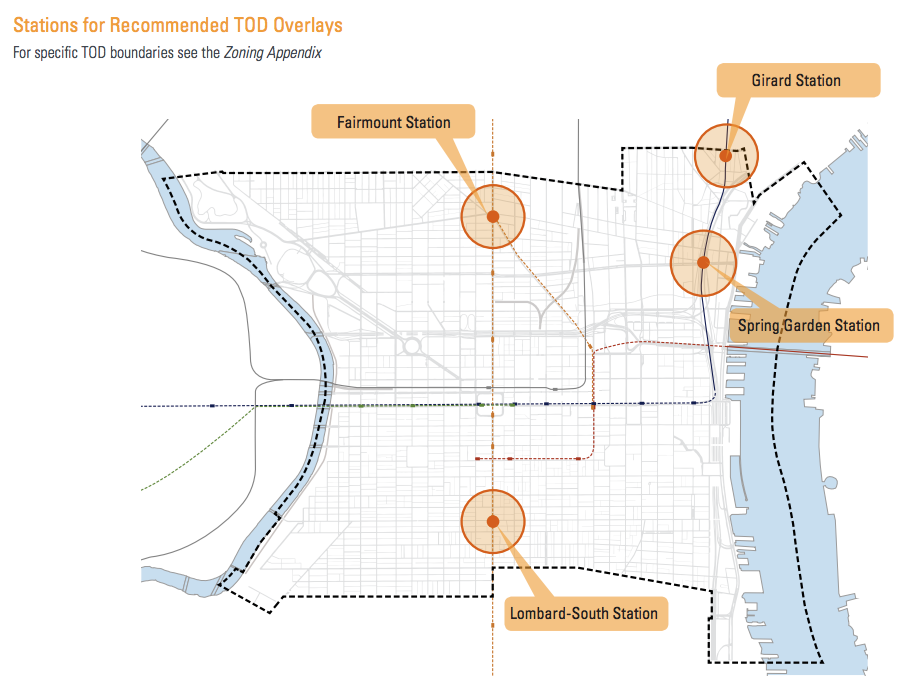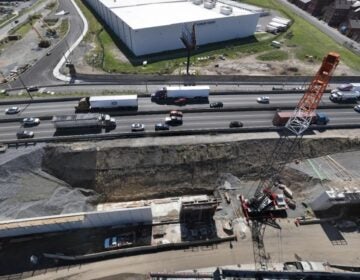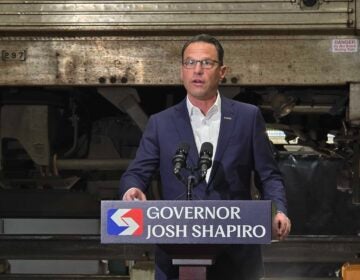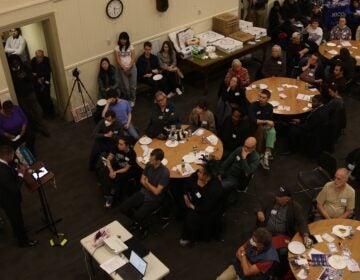Council proposes zoning changes to drive transit-oriented development

When Philadelphia adopted its new zoning code in 2013, policymakers included an overlay provision meant to encourage denser development around transit stations. In theory, it meant that developers could build more densely than the base zoning allowed.
This is meant to encourage what is known as transit-oriented development (TOD) in planning lingo. It’s an idea that’d become increasingly popular among urbanist policymakers: if more people live adjacent to transit hubs, more people will use transit more regularly.
Unfortunately, the TOD Overlay in the code proved unpopular in the extreme. In fact, it’s never once been used, although there are seven currently called for in completed district plans.
That’s why councilmembers Blondell Reynolds Brown and William Greenlee introduced a bill this week to reform the TOD Overlay, aiming to simplify the code and offer stronger incentives. The bill is not meant to earmark any specific stations for the TOD overlay, but will provide an easy-to-use framework that district council people can utilize.
The unused offering currently on the books includes three different types of TODs, featuring distinctions of dubious practical value. It is also encumbered by confusing requirements regarding primary and secondary streets. To make matters more complicated, the exact contours of TOD areas have to be negotiated in every specific case.
The proposed reform would scrap all that and just establish overlays that cover every property within 500 feet of the entrance of a transit station.
“We wanted to simplify it and make it more user friendly,” says Andrew Meloney, a planning commission staffer who helped craft the legislation. “Council offices and others we brought the old TOD overlay to never seemed that interested in getting too deep into it. There wasn’t a lot of comprehension about how TOD could really help.”
The bill introduced in City Council on Thursday would clarify the matter. Any property in the overlay with a base zoning of CMX-3, CMX-4, CMX-5, or RMX-3—the main mixed-use zoning classifications which have floor area ratio (FAR) designations– will get a 30 percent FAR bonus.
It would then grant not just additional density bonuses for green buildings and mixed-income housing—which the current overlay offers—but for public space, underground parking, or transit connections.
Curb cuts will be restricted to enhance the pedestrian experience, while drive throughs and auto-oriented uses, like paid parking lots, will not be allowed. On the ground floor retail, commercial, or public service uses will be required, ensuring mixed-use buildings.
The bonus for mixed-income housing will be increased, from 150 percent of the base density allowed to 200 percent. The land around transit stations is exactly where policymakers would like to see more affordable housing, ensuring that poor and working class Philadelphians can have easy and cheap access to the rebounding jobs base downtown.
The proposed TOD overlay would establish a minimum height requirement of 25 feet, which will prevent the construction of one-story buildings around TOD stops. There are provisions to ensure extra density as well. The overlay will increase the number of allowable dwelling units by 50 percent for areas with a base zoning of CMX-1, CMX-2, CMX 2.5, or RM-1. (If a developer is allowed to build 4 units by the base zoning, in an overlay district they can build 6.)
The bill also reduces the parking minimums, while establishing a maximum parking limit—which would be a first under Philly’s zoning code.
There is some disappointment among transit-activists, who would like to see even more ambitious TOD legislation. The proposed legislation would require negotiations with District Council offices to opt a station into an overlay. The urbanist political action committee 5th Square says it would like to see all the city’s transit stops covered by TOD overlays, which would then require council people to opt out rather than opt in (as they’d have to under the current bill).
5th Square would also like to see a larger radius than 500 feet in the TOD overlays. University of Pennsylvania transportation planning professor Erick Guerra, agrees, describing the proposed 500-foot overlays as “very small.” He also fears that in some cases, SEPTA stations are surrounded by infrastructure—such as the freeways that encase the Spring Garden Station—that would limit the effectiveness of small overlays.
“Overall 5th Square is very excited about TOD,” says Jake Liefer. “The legislation as it currently stands has the TOD overlay within only a 500 foot radius. Most of our peer cities are doing a quarter mile. The minimum threshold is generally twice the proposed amount, so we’d like to see that increased to a quarter mile or half mile.”
The national standard pushed by many transit advocates is a half-mile because it’s a distance that is still walkable to most people. A radius of that size would thus maximize the area in which dense development can be usefully built.
“We are using 500 feet because we want to see a lot of these TODs,” says Meloney. “Not just specific locations that came out of a district plan, but almost anywhere you have a high speed, high frequency station. With the half mile radius, they would just overlap and everything ends up being in a TOD.”
Meloney says that the 500-foot limits will also make the political negotiations simpler. Both the Broad Street and Market-Frankford lines run along arterial streets that are often used to demarcate city council districts. Most of the stations along Philly’s two principal heavy rail lines, where policymakers would most like to see TODs blossom, fall within two council districts. That makes negotiations more complicated and Meloney believes the half-mile radius would only make things trickier. The 500 feet limit is a more effective, targeted, and careful strategy.
“It’s a baby step,” says Meloney. “We introduce something that is easier to use and more effective and then we take it to the council offices. It might not be a lot to start but our hope is that this will be positive and we’ll just keep increasing the stations where TOD is available.”
WHYY is your source for fact-based, in-depth journalism and information. As a nonprofit organization, we rely on financial support from readers like you. Please give today.







